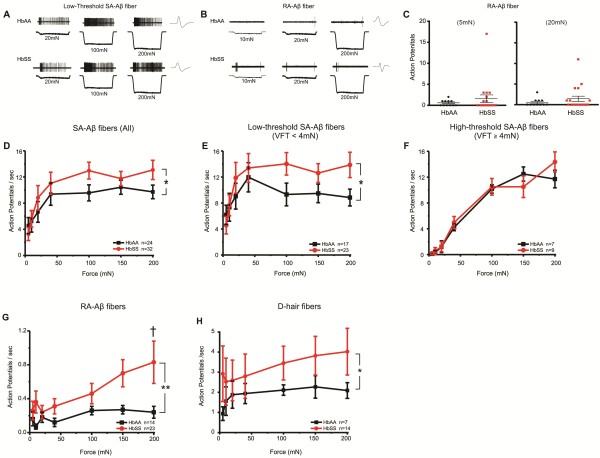Figure 2.
Mechanically-evoked action potential firing increases in HbSS mouse A-fibers. Using the skin-nerve preparation, all recordings were performed in the saphenous nerve and hairy skin of the dorsal hindpaw. Mechanical forces ranging 5-200mN (10 sec) were applied to the most sensitive part of each fiber’s receptive field using a 0.8 mm probe. (A) Examples of responses of low-threshold slowly adapting Aβ (SA-Aβ) fibers from HbAA and HbSS mice to sustained mechanical force at 20, 100, and 200mN. (B) Examples of responses of rapidly adapting Aβ (RA-Aβ) fibers from HbAA and HbSS mice to sustained mechanical force at 10, 20, and 200mN. (C) Mechanically-evoked action potentials in at the onset of 5mN and 20mN force in RA-Aβ fibers. Increased firing in a small percentage (20-25%) of HbSS RA-Aβ fibers suggests a possible subpopulation of sensitized fibers. (D) Overall, all SA-Aβ fibers firing on average 25% more action potentials to mechanical forces (*P <0.05). (E) The differences observed in total SA-Aβ fibers were specific to lower-threshold SA-Aβ fibers, or those with von Frey thresholds < 4mN. On average, the lower-threshold SA-Aβ fibers fired 25% more action potentials in response to mechanical forces in HbSS mice when compared to HbAA controls (*P <0.05). (F) The higher-threshold SA-Aβ fibers, which had a von Frey threshold ≥ 4mN, exhibited similar firing properties between HbSS and HbAA mice (P >0.05). (G) RA-Aβ fibers in HbSS mice fired 75% more action potentials overall (**P <0.01), specifically when compared at 200mN (†). (H) Rapidly adapting Aδ (D-hair) fibers responded with markedly more action potentials (75%) when averaged across all force intensities (*P <0.05) in HbSS mice.

